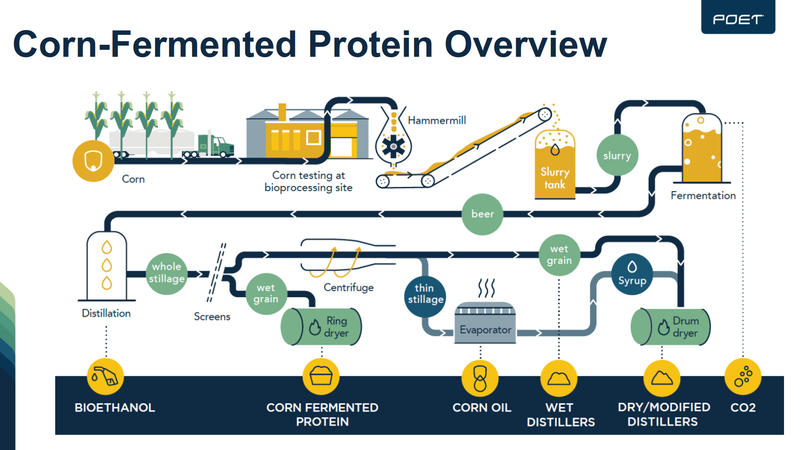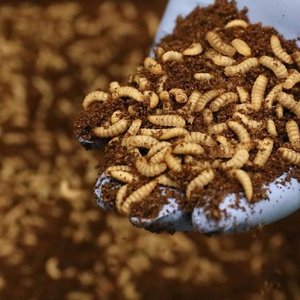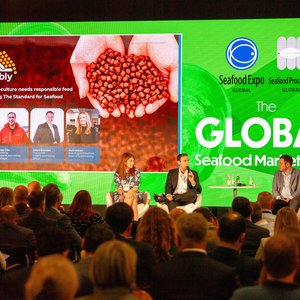In a global context of increased population, more food production is needed to address the projected demand by a global population of ten billion in 2050. To ensure food security, aquaculture must increase from 82 million tons produced in 2018 to 129 million tons by 2050 and aquafeeds and its ingredients will be key.
“In the 1990s, feeds were mainly fishmeal, fish oil, and a bit of wheat to hold it together, and the objective was to understand the fish's nutritional needs to maximize performance. In the 2000s, the formulation pressure was more driven by cost and nowadays by sustainability,” said Brett Glencross, technical director at IFFO – The Marine Ingredients Organisation, at the International Aquaculture Conference organized by the U.S. Grains Council on April 26, 2024 in Barcelona, alongside Seafood Expo Global that gathered together more than 40 aquafeed producers and farmers.
A transition from marine ingredients to plant-based ingredients occurred in the early 2000s. The proportional inclusion of marine ingredients has been reduced from about 20% in 2000s to less than 10% of global feed production for aquaculture nowadays and it is used principally as a strategic ingredient.
“Forty percent of global grain production goes to the feed sector. This sector's forecast will grow by about 465 million metric tonnes by 2032. There is no other resource on the planet that can have that sort of growth. This is why grains will underpin all feeds going forward for the foreseeable future,” Glencross said.
Among these plant-based ingredients, formulators can use in their recipes corn-derived co-products, such as Distilled Dry Grains of Soluble (DDGS) and Corn Fermented Protein (CFP).
DDGS versus CFP
Distillers dried grains with solubles (DDGS) are obtained through a fermentation process that converts all the starch in the corn kernel over to ethanol through fermentation. Everything else in the corn kernel, including protein, fiber and fat, is concentrated to get the DDGS. The CFP process is a bit different since it tries to separate out more of the protein and less fiber to this corn-fermented protein.
CFP was developed to have an additional value in remedy streams. “We wanted to capture as much value as we could from that corn kernel and create additional co-products. DDGS are whatever isn’t fermented over to starch. With CFP, we are trying to select and target a certain protein concentration and certain characteristics. It is more of a designed ingredient, more of a specialized ingredient,” Kevin Herrick, technical service director of nutrition, POET, explained.
“There are many different technologies and processes to obtain CFP, not necessarily better or worse, just different. I suggest formulators talk with their supplier and find out what better works for their species, feed or needs,” Herrick said.

Corn fermented protein production process
“DDGS is 28% protein and CFP can be up to 50-55%. The protein component of DDGS is very good for freshwater fish, while CFP fits well for high protein feeds such as shrimp and marine fish feeds,” Ronnie Tan, regional aquaculture consultant at the U.S. Grains Council, explained. “Since they are fermented, there is highly available phosphorus and also yeast, beta-glucans and xanthophyll. DDGS and CFP do not compete for the same space, regular DDGS can be used for lower protein feed (<33% CP) and CFP for higher protein feed (<33% CP).”
In terms of formulation, in some cases, CFP has more value for certain species based on formulation, species with greater nutrient requirements and the strategy – replacing fishmeal, soybean meal, corn gluten meal, etc. Herrick presented examples in steelhead trout, European seabass and gilthead seabream of how using CFP can end in cost-saving benefits (2.9-3.1%) using some of these different strategies.
“CFP protein products have good digestibility and also benefit from yeast with better lysine concentration. Moreover, CFP has little to no effect on filet pigmentation,” Herrick stated. “CFP represents the next evolution of the distillers industry. The nutrient profile makes it a good opportunity option for aquaculture formulation. It provides an alternative to the ingredients.”
As for DDGS, Professor Deniz Çoban, from Aydin Adnan Menderes University in Turkey, presented results from a study that tested DDGS on rainbow trout looking for affordable and effective alternatives to fishmeal and soybean meal. DDGS were added at 10%, 20% and 30%.
Researchers found lower FCR (1.24), higher weight gain and SGR (1.92) in the DDGS20 group. The use of DDGS in feeds did not have a negative effect on digestibility rates and the activity of the digestive enzymes analyzed increased proportionally as the proportion of DDGS added to the feeds increased. The use of DDGS up to 30% in rainbow trout feeds had no negative effect on skin and fillet color. Finally, the feed cost decreased significantly with the increase in DDGS as a protein source in the feeds.
Corn as a sustainable ingredient
Sustainability has become one of the key issues the aquaculture industry needs to assess while contributing to food security. “The corn industry has been approaching the issue of circularity for a long time. Ethanol is extracted from the corn and once the ethanol is produced you have a co-product, no longer a waste, that is DDGS and CFP. This way, multiple co-products that are no longer waste are available to the market, reducing the carbon intensity of the whole production process and extracting as much value as possible from the same kernel of corn,” said Carlos Suárez, manager of sustainability, policy and innovation at the U.S. Grains Council.
“Over the past 40 years, U.S. corn production has reduced its environmental impact through reduced land use for every bushel of corn that is produced, as well as the amount of irrigation water, energy use, GHG emissions and even erosion. This has been 40 years of continuous improvement in terms of production practices and we have set 2030 sustainability goals to continue along this road of improvement,” Suárez explained.
The U.S. Grains Council supports international buyers of corn products to address supply chain sustainability requirements with two baseline tools, the Corn Sustainability Assurance Protocol (CSAP) and the Sustainable Corn Exports (SCE) web platform.
The CSAP was created to provide international stakeholders with the full scope of the laws and regulations that underpin sustainable production in U.S.-origin corn and its associated products, across multiple impact categories. The SCE web platform leverages the CSAP’s definition of U.S. sustainable corn volumes allowing exporters and importers of U.S. corn products to issue shipment-specific documentation to satisfy sustainability requirements in international markets. These documents are called Records of Sustainability, which U.S. exporters provide to international customers at no cost, to satisfy current entry-level sustainability requirements. The CSAP has also been benchmarked against the Sustainable Agriculture Alliance (SAI) platform.
“If you are an international buyer of corn products, next time you order a shipment, just ask for the record of sustainability from your trader which will be issued for you at no cost,” said Suárez.

From left to right: Mohamed Salah Bouthour, U.S. Grains Council; Kevin Herrick, POET; Carlos Suárez, U.S. Grains Council; Brett Glencross, IFFO; Michiel Fransen, ASC; Deniz Çoban, Adnan University
Synergies with other ingredients
With the variety of ingredients that formulators manage, there is no perfect ingredient. “When you start to understand what are the strengths of one ingredient and the weaknesses of another, then you can find things that actually complement each other,” Glencross said.
So is the case of marine ingredients and grains. “Marine products work very well with grains to facilitate palatability and provide the cost-effective bio-nutrients formulators need. Complementarity becomes really critical in that story,” Glencross said. “Not all palatants are equally effective. Formulators need to find which one is working with the products they are using. It's about understanding that complements change and there is also variability in responses.”
Most palatants tend to be enzymatic or acid hydrolysates of fishery products. “There is an increased demand for marine-based palatants and the sector is going strongly down this path,” Glencross said.
“Modern diets are formulated using a precision nutrition approach, formulating to precise levels of digestible energy and amino acids in those ingredients and all ingredients have an impact hierarchy, with palatability often the biggest factor in that hierarchy. Managing and understanding palatability is increasingly critical in terms of how formulators can vary their useful materials. It's really a matter of taste and marine ingredients are complementary to increasing grain use in feeds,” Glencross concluded.
For more information on how to assess DDGS and CFP sustainability performance, the U.S. Grains Council has handbooks available to download, Precision DDGS Nutrition, and High Protein DDGS Handbook.










